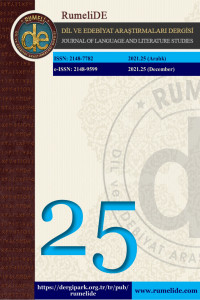Yerel ekosistemler, biyoçeşitlilik ve sürdürülebilirlik: Mary Hunter Austin’in The Land of Journey’s Ending eserinin biyobölgeselci okuması
Öz
Amerikalı yazar Mary Hunter Austin’in biyobölgeselci yaşam sürdürme tutkusu eserlerinde sıklıkla görülen bir olgudur. Bu durum, çevre bilincine sahip daha güçlü bir uygarlık inşa etmeye yardımcı olmak için daha büyük ölçekte uygulanabilir ve küresel homojenleştirici ilişki yerine kendi kendine yeterlilik açısından biyobölgelerin düşünce yapısını vurgular. Bu çalışma Austin’in, Amerika’nın güneybatısında ve toprak ile uyumlu bir şekilde yaşayan yerli halkları anlattığı The Land of Journey’s Ending eserini biyogölgeselci bir bakıç açısıyla incelemektedir. Austin’in kızılderili kültürüne olan derin tutkusu, kızılderililerin oldukça kıymet gösterdikleri yerel tabiata ve doğal koşullarına/özelliklerine uyumlu manevi yaşamları ve kültürel mirasları ile ilgilidir. Austin’in bu eserinde yerel kültürü, siyaseti ve ekonomileri korumaya yaptığı vurgu, özellikle küresel monokültür krizine bir yanıt olarak, modern bağlamda biyogölgeselciliğin potansiyel etkisi hakkındaki anlayışın derinleşmesine katkıda bulunabilir. Bu nedenle, bu çalışma Austin’in eserinin, insanların yerel bir bağlama dayalı olarak doğal dünya ile nasıl faydalı bir ilişki kurması gerektiği konusundaki konumunu ortaya çıkarmayı amaçlamaktadır.
Anahtar Kelimeler
Yerellik biyobölgeselcilik biyoçeşitlilik kültür sürdürülebilirlik
Kaynakça
- Austin, M. H. (2007). The land of journey’s ending. Santa Fe: Sunstone Press.
- Buell, L. (2005). The future of environmental criticism: environmental crisis and literary imagination. Oxford: Blackwell Publishing.
- Champion, L. (2000). American women writers, 1900-1945: a bio-bibliographical critical sourcebook. London: Greenwood Press.
- Garces, V. C. (2011). "Ecocriticism and translation." Odisea, 12,pp. 257-272.
- Klimasmith, B. (2004). “Naturist as Tourist: Mary Austin’s “Automobile Eye View” in The Land of Journey’s Ending.” Western American Literature, Volume 39, Number 1, pp. 54-78.
- Lanigan, E. F. (1989). Mary Austin: song of a maverick. New Heaven: Yale University Press.
- Lynch, T. (2008). Xerophilia: ecocritical explorations in Southwestern literature. Lubbock: Texas Tech University Press.
- Norwood, V. (1993). Made from this earth: American women and nature. Chapel Hill and London: The University of Carolina Press.
- Petterson, J. (2008). “Wrestling with “half gods”: Biblical Discourse in Mary Austin’s The Ford.” Christianity and Literature, Vol. 67 (4), pp. 653-668.
- Sale, K. (2000). Dwellers in the land: the bioregional vision. Athens: The University of Georgia Press.
- Schaefer, H. (2004). Mary Austin’s regionalism: reflections on gender, genre, and geography. Charlottesville and London: University of Virginia Press.
- Stineman, E. F. L. (1987). “Mary Hunter Austin: an American woman of letters.” Dissertation for the Degree of Doctor of Philosophy, Faculty of the Graduate School, Yale University.
- Thayer Jr., R. B. (2003). Life place: bioregioal thought and practice. California: University of California Press.
- Warren, J .P. (2014). The road to the spring: collected poems of Mary Austin. New York: Syracuse University Press.
Local ecosystems, biodiversity and sustainability: bioregional reading of Mary Hunter Austin’s The Land of Journey’s Ending
Öz
American writer Mary Hunter Austin’s passion for living a bioregional lifestyle is conveyed in her works, which may be applied on a larger scale to help build a stronger civilization that is environmentally minded and emphasizes the mindset of bioregions in terms of self-sufficiency rather than global homogenizing interconnectedness. This study examines Austin’s literary non-fiction, The Land of Journeys’ Ending, from a bioregional lens, as it focuses on the American Southwest and its indigenous inhabitants, who live harmoniously with the land. Austin’s passion for Native American culture was profound as were her convictions about their lifestyle, including their spiritual life and cultural heritage, which were adapted to suit the local landscape and its natural conditions/features that they highly valued. The emphasis on preserving local culture, politics, and economies of Austin’s work could contribute to deepening the understanding of bioregionalism’s potential influence in a modern context, especially as a response to the global monoculture crisis. Thus, the paper delves into Austin’s notable work in an effort to reveal her position about how humans should construct a beneficial relationship with the natural world based on a local context.
Anahtar Kelimeler
Kaynakça
- Austin, M. H. (2007). The land of journey’s ending. Santa Fe: Sunstone Press.
- Buell, L. (2005). The future of environmental criticism: environmental crisis and literary imagination. Oxford: Blackwell Publishing.
- Champion, L. (2000). American women writers, 1900-1945: a bio-bibliographical critical sourcebook. London: Greenwood Press.
- Garces, V. C. (2011). "Ecocriticism and translation." Odisea, 12,pp. 257-272.
- Klimasmith, B. (2004). “Naturist as Tourist: Mary Austin’s “Automobile Eye View” in The Land of Journey’s Ending.” Western American Literature, Volume 39, Number 1, pp. 54-78.
- Lanigan, E. F. (1989). Mary Austin: song of a maverick. New Heaven: Yale University Press.
- Lynch, T. (2008). Xerophilia: ecocritical explorations in Southwestern literature. Lubbock: Texas Tech University Press.
- Norwood, V. (1993). Made from this earth: American women and nature. Chapel Hill and London: The University of Carolina Press.
- Petterson, J. (2008). “Wrestling with “half gods”: Biblical Discourse in Mary Austin’s The Ford.” Christianity and Literature, Vol. 67 (4), pp. 653-668.
- Sale, K. (2000). Dwellers in the land: the bioregional vision. Athens: The University of Georgia Press.
- Schaefer, H. (2004). Mary Austin’s regionalism: reflections on gender, genre, and geography. Charlottesville and London: University of Virginia Press.
- Stineman, E. F. L. (1987). “Mary Hunter Austin: an American woman of letters.” Dissertation for the Degree of Doctor of Philosophy, Faculty of the Graduate School, Yale University.
- Thayer Jr., R. B. (2003). Life place: bioregioal thought and practice. California: University of California Press.
- Warren, J .P. (2014). The road to the spring: collected poems of Mary Austin. New York: Syracuse University Press.
Ayrıntılar
| Birincil Dil | İngilizce |
|---|---|
| Konular | Dilbilim |
| Bölüm | Dünya dilleri, kültürleri ve edebiyatları |
| Yazarlar | |
| Yayımlanma Tarihi | 21 Aralık 2021 |
| Yayımlandığı Sayı | Yıl 2021 Sayı: 25 |


